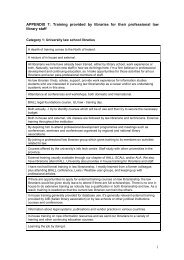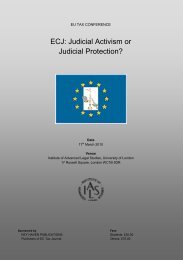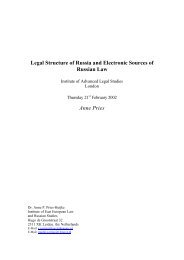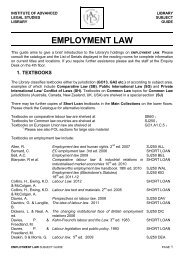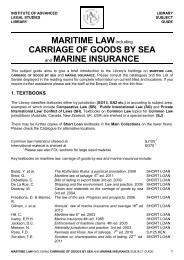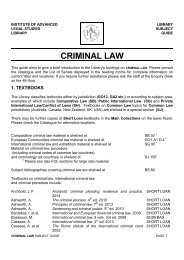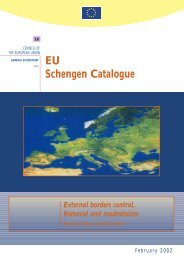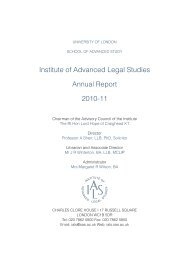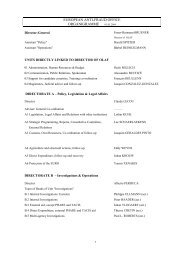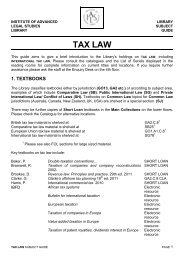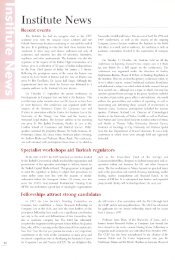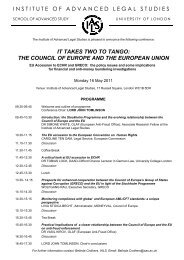a thesis - Institute of Advanced Legal Studies
a thesis - Institute of Advanced Legal Studies
a thesis - Institute of Advanced Legal Studies
Create successful ePaper yourself
Turn your PDF publications into a flip-book with our unique Google optimized e-Paper software.
70 EXPRESS TRUSTS.<br />
intention <strong>of</strong> the parties." (Sackville-West v. Viscount Holmesdalc<br />
(1870), L. E. 4H. L. at p. 554.)<br />
Illustrations.<br />
1. A. devises property to B. for payment <strong>of</strong> debts and legacies<br />
and afterwards to settle the remainder; and what remains unsold a<br />
moiety to C. and the heirs <strong>of</strong> his body by a second wife; taking<br />
special care in such settlement that it never be in the power <strong>of</strong> C. to<br />
dock the entail during his life. C. is only entitled to a life estate.<br />
Leonard v. Earl <strong>of</strong> Sussex (1705), 2 Yern. 526.<br />
2. A. devises [sz'c] 3007. to be laid out by her executrix in lands<br />
and settled to the only use <strong>of</strong>: her daughter B. and her children ;<br />
and if she die without issue the lands to be equally divided between<br />
her brothers and sisters then living. There being no evidence <strong>of</strong><br />
a contrary intent, B. takes an estate tail. Siceetapple v. Bindon<br />
(1705), 2 Yern. 536.<br />
3. A. devises real estate to X., Y. and Z. upon trust (by advice<br />
<strong>of</strong> counsel] to convey the same to the first son <strong>of</strong> B. for ninety-nine<br />
years if he should so long live, remainder to the heirs male <strong>of</strong> the<br />
body <strong>of</strong> such first son, with remainders over. The intention being<br />
to make as strict a settlement as possible, the conveyance in<br />
pursuance <strong>of</strong> this will must, after the limitation to the first son <strong>of</strong><br />
B., contain a limitation to trustees during his life to preserve<br />
contingent remainders. Stamford v. Hobart (1710), 3 Brown<br />
P. C. 31.<br />
[Note.—If the limitation to trustees to preserve contingent<br />
remainders were not inserted, the contingent remainder to the<br />
heirs male <strong>of</strong> the first son <strong>of</strong> B. would fail for want <strong>of</strong> a particular<br />
estate <strong>of</strong> freehold.]<br />
4. A. by will gives personal estate to be laid out in the purchase<br />
<strong>of</strong> lands for B. and the heirs male <strong>of</strong> his body to be begotten for<br />
ever; and for want <strong>of</strong> such issue, to C. and the heirs male <strong>of</strong> his<br />
body to be begotten for ever; with remainders over, and appoints<br />
C. his executor. B. takes an estate tail. Seal v. Seal (1715),<br />
Precedents in Chancery, 421.<br />
[Note.—This case is also reported in 1 P. Wms. 290, and 2 Eq.<br />
Abr. 346, which state that there was a direction to settle the lands<br />
on B. and his heirs male which would make it an executory trust,<br />
but this is omitted in the Prec. in Ch. report, and in its absence



